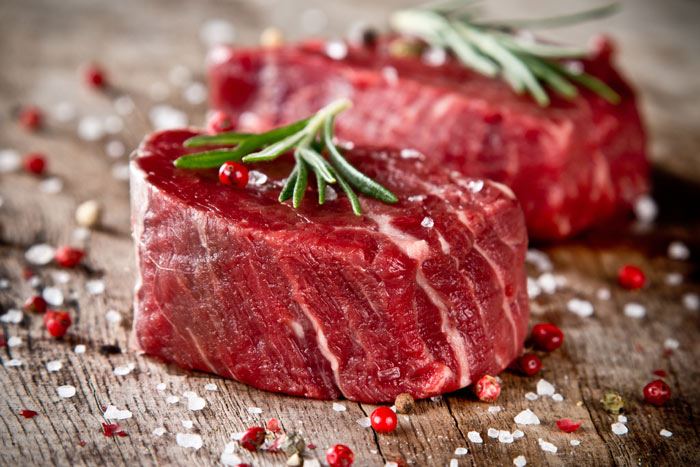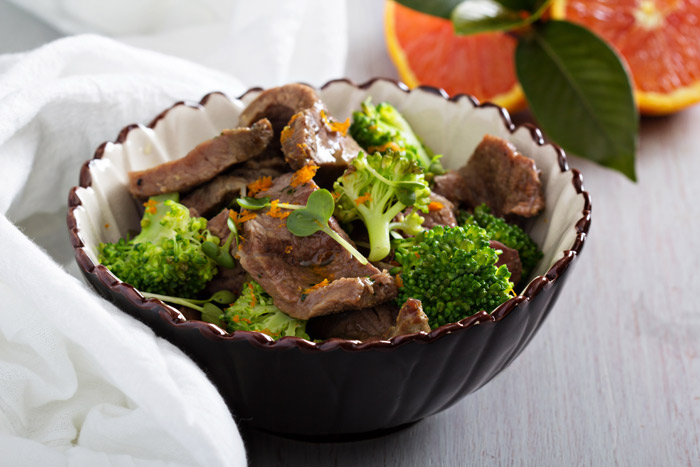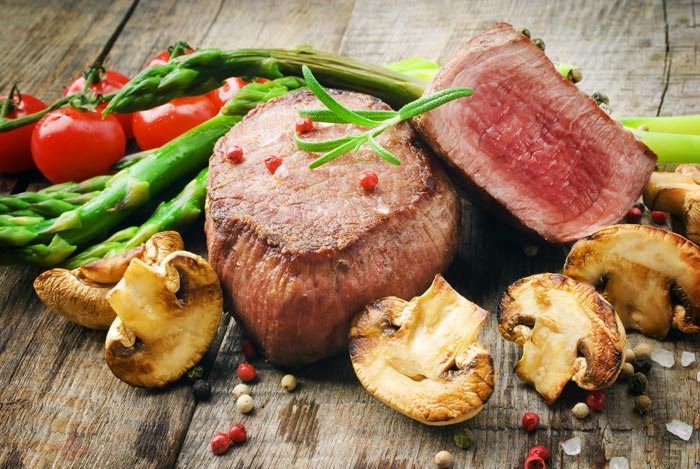Table of Contents
Few things are certain in nutrition. A food that is lionized today could be demonized tomorrow. A health supplement that was “proven” in 2012 to do wonders for our body could, 20 years later, be conclusively shown to trigger long-term complications.
Sadly, due to the complexity of our bodies and the biological mechanisms by which it processes nutrients, we still know little about human nutrition. Indeed, there are some nutrients we have yet to discover, let alone assess and analyze.
However, some things in nutrition are certain. For example, we can say with absolute conviction that the reason we are alive right now, healthy and largely disease-free, is because our ancestors survived for thousands of years on animal-based foods.
Seafood, chicken, eggs, insects… we consumed them all. And we evolved to become the most intelligent beings on this planet.

A diet rich in natural meat played a significant role in the development of our brains
In this article, we take a detailed look at one of the most beloved meats of all: beef. Specifically, beef from cows allowed to enjoy their natural grass diet.
Why Is Grass-Fed Beef Good for You?

According to NutritionData, 100 grams of ground, grass-fed beef is:
Since the nutrients in beef vary depending on which part of the animal we consume and the quality of the meat itself, the data above should be taken with a grain of salt. As a general rule, though, beef tends to be rich in protein, iron, saturated fat (including omega-3 fatty acids), zinc and most B vitamins. Its nutrient profile is representative of most ruminants, though lamb is a little more nutritious in the mineral department.
Research into the Health Benefits of Grass-Fed Beef
Rich in Cancer-Fighting Conjugated Linoleic Acid
Grass-fed beef is one of the finest natural sources of conjugated linoleic acid (CLA), a somewhat rare fatty acid that possesses numerous health benefits, including anti-cancer properties. For example, check out what the following studies have discovered about CLA:

Beef is one of the best sources of disease-fighting CLA
In summary, conjugated linoleic acid is proven to be a fantastic anti-cancer agent and possible weight loss aid. This is quite ironic, since government propaganda has long held that regular consumption of beef (and other forms of red meat that contain CLA) is linked to the exact opposite.
According to an in-depth review published in the Nutrition Journal in 2010, grass-fed species produce 2 to 3 times more conjugated linoleic acid than grain-fed species, mostly due to “more favorable rumen pH” (7).
High in Complete, Easily-Digestible Protein
100 grams of ground, grass-fed beef contains approximately 19.4 grams of protein, which is 39% of our daily value (DV). Better still, the protein in beef is extremely high-quality.
Aside from being a complete protein that contains all 9 essential amino acids (compounds that our bodies cannot manufacture themselves, meaning they need to obtain them from food sources), beef protein scores an impressive 0.92 on the Protein Digestibility Corrected Amino Acid Score (PDCAAS), which is a method of evaluating the digestibility of protein (8). Though this isn’t as high as the perfect 1.0 score achieved by egg whites and certain milk proteins, it proves that beef is still a fantastic protein source!

Why bother with unnatural protein shakes when nutritious whole foods, such as beef, provide much higher-quality protein?
While most people are aware that protein aids the growth and repair of cells, it also plays a number of other important biological roles. Different proteins guard us from infection, aid substance transportation, and even send signals around the body (the protein insulin, for instance, regulates fat and carbohydrate metabolism).
An Excellent Source of Bioavailable Heme Iron
100 grams of ground, grass-fed beef also contains approximately 1.7 milligrams of iron, which is 9% of our DV. This might not seem like a huge amount, but we need to consider the quality.
Like protein, which can be complete or incomplete, iron also comes in 2 forms: heme and non-heme. Non-heme iron is found in plant foods and has an absorption rate of 2-20%. Heme iron, on the other hand, is found in animal foods and has a higher absorption rate of 7-35% (9).
The result? Heme iron from animal foods is more efficiently absorbed than non-heme iron from plant sources. Therefore, while some plants, such as spinach, might contain more iron per weight than beef on paper, our bodies are more likely to actually use the iron from beef.

The iron in beef is more bioavailable than the iron in broccoli, but that doesn’t mean you shouldn’t eat broccoli!
Iron is best-known for working with the proteins in our body to manufacture hemoglobin, a hemoprotein that transports oxygen from the lungs to the body tissues. It is also required for the proliferation of T-cells (small cells that orchestrate the immune system’s response to infection), the synthesis of several important neurotransmitters (such as serotonin and dopamine), and more.
Did you know?
Like eggs and countless other natural foods, red meat was a victim of the twentieth century’s vicious attack on saturated fats. Through faulty and cherry-picked data, nutritionists led the public to believe that saturated fat – present in beef – was linked to high cholesterol and other supposed markers of heart disease.
Needless to say, these claims are long discredited; there is no significant link between consuming naturally-sourced saturated fat and cardiovascular problems. Virtually all health issues associated with meat consumption are related to the poor quality of the meat itself.
A Great Source of Omega-3 Fatty Acids
Omega-3 and omega-6 fatty acids are essential polyunsaturated fats responsible for building cells and maintaining brain and nerve function. Moreover, since our bodies cannot manufacture them, we need to obtain these important nutrients from food sources.
Unfortunately, the advent of processed seed and vegetable oils – which are high in omega-6 and low in omega-3 – have wreaked havoc on our fatty acid ratios. Whereas nutritionists agree that the optimum omega-3 and omega-6 fatty acid ratio is 1:4, followers of the Standard American Diet (SAD) are likely to have ratios closer to 1:16 in favor of omega-6 fatty acids – a severe imbalance that can contribute to long-term inflammation.

Sunflower oil, whose omega-6 fatty acid content often approaches 70%, is one of the biggest contributors to fatty acid imbalances
For this reason, it’s important that we reduce our intake of omega-6 fatty acids (simply cutting out vegetable and seed oils is a good start) while increasing our intake of omega-3 fatty acids. One of the easiest ways to achieve the latter, of course, is to eat more foods rich in high-quality omega-3 fatty acids, namely, animal foods!
Unsurprisingly, meat from grass-fed ruminants is proven to contain significantly higher levels of omega-3 fatty acids than the meat of ruminants subjected to grain-based diets. Levels of omega-6 fatty acids, on the other hand, remained the same for both groups (11).
Packed with Creatine and Carnosine
Grass-fed beef is also an excellent source of creatine and carnosine, two lesser-known nutrients that are only found in animal foods. According to research published in the journal Proceedings of the Royal Society B, creatine supplementation had a “significant positive effect” on working memory and intelligence in human volunteers (12). Another study, published in the British Journal of Nutrition, found that creatine supplementation could improve the memory of vegetarians (13).
Carnosine, on the other hand, tends to function as a disease-fighting antioxidant. A review published in the journal Science of Aging Knowledge Environment noted that carnosine reduced oxidative stress and prevented DNA damage (14). A second study, featured in the journal Biochemistry, acknowledged that carnosine was an effective free radical scavenger and potentially possessed anti-aging benefits (15).

Yup, meat contains antioxidants just like fruits and vegetables do
Summary of Grass-Fed Beef’s Benefits
Aside from being rich in complete protein and heme iron (the highest-quality sources of these two essential nutrients), grass-fed beef is a fantastic source of cancer-fighting CLA, brain-boosting creatine and omega-3 fatty acids, and the natural antioxidant carnosine… and those are just the nutrients of which we are currently aware.
The bottom line is that beef is good for everyone. It is one of the most important components of our ancestral diet, and by choosing to give up beef (and other meats), we are putting our long-term health in serious jeopardy.
Selecting and Storing Beef
The healthiest beef to consume is, without a doubt, grass-fed (aka pasture-raised) beef from certified organic farms. Organic beef is far less likely to be contaminated by antibiotics, pesticides and hormone residues, and it is also illegal for it to be genetically modified or irradiated. Furthermore, cows from organic farms are treated much more humanely than cows from conventional farms.
Though organic beef can be purchased in supermarkets, I prefer to purchase it directly from the organic farms themselves. Many local organic farms operate a home delivery system, whereby you order your food online and then have it delivered to your door on a certain day of the week. Some of these farms welcome visitors, allowing you to assess their standards of hygiene and ethnics in person.

Organic farms produce the healthiest meat from the happiest cows
Since beef spoils easily, it should always be refrigerated or frozen. As a general rule, ground beef keeps for around 1-2 days, steaks for 2-3 days and roasts for 3-4 days. Larger pieces of beef tend to keep for longer than pieces with a larger surface area, but the dates on the packaging tend to be the most accurate indication of shelf life.
Cooking Beef
While organic, grass-fed beef is a lot cleaner than conventional beef, it still needs to be cooked to ensure that all harmful bacteria are killed. Ground beef in particular must be cooked thoroughly, since the grinding process exposes the interior meat to bacteria (unlike muscle meat, whose interior is sterile).
For obvious reasons, I never recommend consuming raw beef. Any nutritional benefits from raw meat are almost always overshadowed by the risk of parasites, and no-one wants that (except for those who want to give the tapeworm diet a chance, of course).







